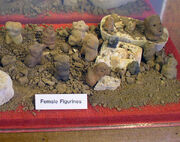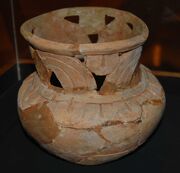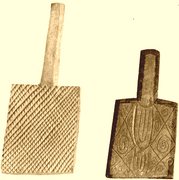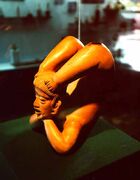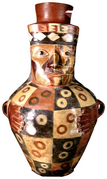
Moche portrait vessel, Musée du quai Branly, ca. 100—700 CE, 16 x 29 x 22 cm

Jane Osti (Cherokee Nation), with her award-winning pottery, 2006
Native American pottery is an art form with at least a 7500-year history in the Americas.[1] Pottery is fired ceramics with clay as a component. Ceramics are used for utilitarian cooking vessels, serving and storage vessels, pipes, funerary urns, censers, musical instruments, ceremonial items, masks, toys, sculptures, and a myriad of other art forms.
Due to their resilience, ceramics have been key to learning more about Precolumbian indigenous cultures.
Materials and techniques[]
The clay body is a necessary component of pottery. Clay must be mined and purified in an often laborious process, and certain tribes have ceremonial protocols to gathering clay. Different tribes have different processes for processing clay, which can include drying in the sun, soaking in water for days, and repeatedly running through a screen or sieve. Acoma and other Pueblo pottery traditionally pound dry clay into a powder and then remove impurities by hand, then running the dry powder through a screen, mixing it with a dry temper, and then mixing water to create a plastic paste.[2] In preparing the clay, potters spend hours wedging it to remove air pockets and humidity that could easily cause it to explode during firing. The clay then needs to "cure" over time.[3]
Coiling is the most common means of shaping ceramics in the Americas. In coiling, the clay is rolled into a long, thin strands that are coiled upon each other to build up the shape of the pottery. While the potter builds the coils up, she also blends them together until there was no trace of the ropes of clay entwined to form the pot, no deviation in the thickness of the walls, and therefore no weaknesses. Potter's wheels were not used prior to European contact and are only used today by a limited number of Native American artists. Pinch pots and other small clay objects could be formed directly by hand. Hohokam potters and their descendents in the American Southwest employed the paddle-and-anvil technique, in which the interior clay wall of a pot was supported by an anvil, while the exterior was beaten with a paddle, smoothing the surface.[4] In precontact South America, ceramics were mass-produced using molds.
Slip is a liquid clay suspension of mineral pigments applied to the ceramics before firing. Slips are typically red, buff, white, and black; however, Nazca culture ceramic artists in Peru perfected 13 distinct colors of slips. They also used a hand-rotated turntable that allowed all sides of a ceramic piece to be painted with ease. These were first used in 500 BCE and continue to be used today.[5] Slips can be applied overall in washes, creating large color fields, often with cloth, or they can be painted in fine detail with brushes. Yucca leaves, chewed slightly to loosen fibers, make excellent brushes that are still in use today in the American Southwest. Negative painting is a technique employed by precontact Mississippian potters in the Eastern Woodlands, Mayan potters in Mesoamerica, and others, which involves covering the ceramic piece in beeswax or another resist, incised a design in the resist, then soaking the piece with a slip. In the firing process the resists melts away, leaving the colored design.
While still green, pottery can be incised with designs. Cords, textiles, baskets, and corncobs have been rolled over wet clay, both as a decoration and to improve heat dispersion in cooking pots. Carved wood or ceramic stamping paddles are used throughout the Southeastern Woodlands to create repeating designs. Clay can also be added to the main ceramic structure to build up designs.
Before firing, ceramics can be burnished or polished to a fine sheen with a smooth instrument, usually a stone. Glazes are seldom used by indigenous American ceramic artists. Grease can be rubbed onto the pot as well.[2]
Prior to contact, pottery was usually open-air fired or pit fired; precontact Indigenous peoples of Mexico and Pueblo people did make limited use of kilns. Today many Native American ceramic artists use kilns. In pit-firing, the pot is placed in a shallow pit dug into the earth along with other unfired pottery, covered with wood and brush, or dung, then set on fire whereupon it can harden at temperatures of 1400 degrees or more. Finally, the ceramics surface is often polished with smooth stones.
Tempers[]
Tempers are non-plastic materials added to clay to prevent shrinkage and cracking during drying and firing of vessels made from the clay.[6] Tempers may include:
- Bone;[7]
- Chaff;[7]
- Charcoal;[8]
- Wood ash;[9]
- Grit;[6]
- Sand, crushed sandstone;[3]
- Crushed limestone;[10]
- Crushed igneous rocks, such as volcanic rock, feldspar, or mica;[11][9][12]
- Grog (crushed potsherds);[3]
- Plant fiber;[13]
- Mollusc shells, freshwater and marine (sometimes fossilized), crushed;[6][14]
- Freshwater Sponge spicules.[15][9][16]
Not all Native American pottery requires added tempers; some Hopi potters use pure kaolin clay that does not require tempering.[3] Some clays naturally contain enough temper that they do not required additional tempers. This includes mica or sand in clays used in some Taos Pueblo, Picuris Pueblo, and Hopi pottery,[2] and sponge spicules in the clay used to produce the "chalky ware" of the St. Johns culture.[16]
Ceramics are often used to identify archaeological cultures. The type of temper (or mix of tempers) used helps to distinguish the ceramics produced by different cultures during particular time periods. Grog, sand, and sandstone were all used by Ancestral Pueblo people and other Southwestern cultures.[3] Crushed bone was used as temper in at least some ceramics at a number of sites in Texas.[17] In the Southeastern United States, the earliest ceramics were tempered with fiber such as Spanish moss and palmetto leaves. In Louisiana, fiber as tempering was replaced first by grog and later by shell. In peninsular Florida and coastal Georgia sand replaced fiber as tempering.[18][19] Still later, freshwater sponge spicules became an important temper in the "chalky ware" of the St. Johns culture in northeastern Florida.[16] Locally produced ceramics of the Lucayan people in the Bahamas were characterized by crushed conch shell tempering, as opposed to the quartz sand-tempered ware imported from Hispaniola.[20]
The choice of temper used in ceramics was constrained by what was available, but changes in the choice of temper can provide clues to influence and trade relations between groups. Shell-tempered ware was produced sporadically in various places across the eastern United States, but in the late Woodland and early Mississipian periods it became the predominant temper used across much of the Mississippi Valley and middle gulf coast, and a major defining characteristic of Mississippian culture pottery.[21][22]
Cultural regions[]
Arctic[]
Several Inuit communities, such as the Netsilik, Sadlermiut, Utkuhiksalik, and Qaernerimiut created utilitarian pottery in historic times,[23] primarily to store food. In Rankin Inlet, Nunavut, Canada, when the mine that employed much of the community closed down, the national government created the Rankin Inlet Ceramics Project, whose wares were successfully exhibited in Toronto in 1967. The project floundered but a local gallery revived interest in Inuit ceramics in the 1990s.[24]
Eastern Woodlands[]
- Hopewell pottery is the ceramic tradition of the various local cultures involved in the Hopewell tradition (ca. 200 BCE to 400 CE)[25] and are found as artifacts in archeological sites in the American Midwest and Southeast.
- Mississippian culture pottery is the ceramic tradition of the Mississippian culture (800–1600 CE) found as artifacts in archaeological sites in the American Midwest and Southeast.
Southeastern Woodlands[]
Fiber-tempered ceramics associated with shell middens left by Late Archaic hunter-fisher-gatherers appeared in the Atlantic coastal plain of Florida, Georgia and South Carolina starting in 2500 BC. The earliest attested pottery is in the Stallings culture area, around the middle Savannah River. Fiber-tempered pottery of the Orange culture in northeast Florida has been dated to 2000 BC or a bit earlier.[26][27] Fiber-tempered pottery of very similar form spread along coasts and river valleys of the Southeastern United States from the Atlantic coast into Alabama, reaching northwestern Florida (Norwood culture) and the Gulf coast by 1300 BC, the interior Middle South by 1100, and Poverty Point by 1000 BC.[28][29]
The similarities of the Stallings series ceramics to the earlier Puerto Hormiga ceramics of Colombia, which were both associated with shell middens, and the presence of winds and ocean currents favoring journeys from South America to the Southeastern United States, led James A. Ford, among other archaeologists, to offer the hypothesis that the two areas had connections, and that the technology of fiber-tempered ceramics in the southeastern United States had been imported from Colombia. Other archaeologists have noted that there are no known archaeological sites between Colombia and Florida that are of a type or age consistent with such connections, and that the cultural traditions of the Southeastern United States show no significant changes associated with the appearance of ceramics, indicating that there was no migration or people, and no transfer of technology or other elements of culture, other than the appearance of ceramics.[30]
- Poverty Point culture, (Poverty Point), Louisiana and Mississippi beginning about 2200 BCE and lasting to about 700 BCE, during the late Archaic period in the Americas,[31]
- Adena culture, central United States around Illinois to Ohio, 3000 BP to 2100 BP
- Hopewell pottery, ceramics of the Hopewell tradition of the central United States throughout Ohio and Illinois circa 2200 BP – 1600 BP
- Mississippian culture pottery, ceramics of the Mississippian cultures of the Eastern United States from around 800 CE to the historic era, including Cahokia in Western Illinois, the major Mississippian chiefdom and the Natchez people, a historic tribe known also to be one of the last of the culturally Mississippian chiefdoms in southwestern Mississippi.
- Fort Ancient pottery, made by a Mississippian influenced group that flourished from 1000–1750 CE along the Ohio River in areas of modern-day southern Ohio, northern Kentucky, southeastern Indiana and western West Virginia.[32]
Great Basin[]
Indigenous peoples of the Great Basin based their pottery on basketry. The Fremont culture of central Utah (700–1300 CE) developed pottery after adopting agriculture. Paiute and Washoe people in the western Great Basin developed plain, utilitarian ceramics separately, which was not burnished but occasionally featured red painted designs. The Owens Valley Brown Ware is an example of Paiute/Washoe ceramics, which was used for cooking, food storage, and water jugs. The jugs often featured clay handles that accommodated carrying straps.[33]
Southwestern cultures (Oasisamerica)[]
Pueblo cultures[]

Ceramic bowl from Chaco Canyon in New Mexico, Pueblo III phase
Deer effigy, pottery. Cochiti Pueblo
- Further information: Cibola White Ware, Rio Grande Glaze Ware, Rio Grande White Ware, y Storyteller doll
- Ancestral Pueblo
- Mogollon culture, including Mimbres culture, which produced Mimbres pottery
- Santa Clara Pueblo, Taos Pueblo, Hopi, San Ildefonso Pueblo, Acoma Pueblo and the Zuni. Noted individuals involved in Pueblo pottery include Nampeyo of the Hopi, and Maria and Julian Martinez of San Ildefonso Pueblo. In the early 1900s, Maria Martinez and her husband Julian rediscovered how to make the traditional Black-on Black pottery, for which San Ildefonso Pueblo would soon become widely known.
| Pottery Style | Time Period |
|---|---|
| Late Basketmaker II Era | 50 BCE-450 CE |
| Basketmaker III Era | 450 CE-700 CE |
| Pueblo I Era | 700-900 |
| Pueblo II Era | 900-1100 |
| Pueblo III Era | 1100–1300 |
| Pueblo IV Era | 1300–1600 |
| Historic | 1600–1880 |
| Modern | 1880–1950 |
| Contemporary | 1950–present[34] |
O'odham cultures[]
- Hohokam, Tohono O'odham, Akimel O'odham
Athabaskan[]
Southern Athabaskans include the Apache and Navajo (Diné).
Other[]
- The Salado culture (1150–15th century CE) of Arizona and New Mexico produced Salado Polychrome.
- Casas Grandes
Mesoamerican pottery[]
Maya funerary urn
- Tlatilco (circa 1500 BCE)
- Olmec (ca. 800-400 BCE)
- Teotihuacan (ca. 300 BCE-600 CE)
- Zapotec (ca. 200 CE- 800 CE)
- Mixtec(ca. 900 CE)
- Tarascan (ca. 800 CE-1300 CE)
- Maya ceramics (ca. 317 CE-1200 CE)
- Remojadas (ca. 750 CE)
- Toltec / Mayan (ca. 1200 CE-1500 CE)
- Aztec (ca. 1168 CE-1519 CE)
- Coclé, Panama with the following periods: La Mula (ca. 150 BCE-300 CE), Tonosi (ca. 300 CE-550 CE), Cubita (ca. 550 CE-700 CE), and Gran Cocle'(ca. 1200 CE-1500 CE).
- Classic Veracruz Culture (ca. 100-1000 CE)
Circum-Caribbean[]
Antilles[]
Ceramics first appeared in the Antilles as part of the Saladoid culture (named for the Saladero site in the Orinoco basin in Venezuela. Saladoid people appeared in Trinidad around 500 BC or a little later, and had reached Puerto Rico by about 250 BC. The Cedrosan variety of Saladoid ceramics appeared in Trinidad early on, although ceramics in the Antilles continued to closely resemble forms on the Venezuela coast into the Current Era. Cedrosan Saladoid vessels have a distinctive bell shape with "zone-incised cross-hatching". Many also have complex designs of white on red paint. Later examples were decorated with purple, black, yellow and orange paint. These ceramics are described as "technologically fine, delicate, and graceful."[35][36]
Other ceramics styles are also known from the Antilles during this time period. Barrancoid trade wares, of a style that had developed in the Orinoco River valley around 1000 BC, have been found in the southernmost Antilles; Trinidad, Tobago, and Saint Vincent. A variant of Saladoid ceramics called Huecan has been found from the north coast of Venezuela to Puerto Rico.[37]
Colombia and Venezuela[]
Fiber-tempered ceramics associated with shell middens left by hunter-fisher-gatherers of the Early Northwest South American Littoral appeared at sites such as Puerto Hormiga, Monsú, Puerto Chacho, and San Jacinto in Colombia by 3100 BC. Fiber-tempered ceramics at Monsú have been dated to 5940 radiocarbon years before present. The fiber-tempered pottery at Puerto Hormiga was "crude", formed from a single lump of clay. The fiber-tempered pottery at San Jacinto is described as "well-made". Sand-tempered coiled ceramics have also been found at Puerto Hormiga.[38][39][40]
Andean region[]
- Further information: Huaco (pottery)
Moche Crawling Feline, a stirrup spout vessel with shell inlay, ca. 100–800 CE
In the Andes, ceramics appear during the Initial Period around 1800 BCE. They were needed for boiling agricultural foods.[41] Chavín potters on the Peruvian coast create distinctive stirrup spout vessels, both incised and highly burnished. These thin-walled effigy pots were fashioned to resemble stylized humans, plants, and animals. Two substyles of Chavín stirrup spout pots include the thicker-walls, glossy-on-matte blackware Cupisnique style and red and black Santa Ana style, both featuring fanged heads.[42] Subsequent Andean cultures revived these ancient ceramics styles and imagery.[43]
Paracas culture, from Peru's desert south coast, created highly detailed ceramics, that were often painted after firing. Paints, made with an acacia resin binder, were commonly warm yellow, olive green, red-orange, white, and black in color. Paracas artists built upon Chavín styles and introduced the double spout-and-bridge vessel and distinctive masks portraying a supernatural "Oculate Being," that combines human, owl, and double-headed snake forms.[44]
Nasca culture, another south coastal Peruvian culture, returned to the less fragile practice slip-painted their ceramics prior to firing. They created thirteen distinct colors, the larger palette found in Pre-Columbian ceramics in the Americas, which included rare pale purple, maroon, and bluish-grey. Nasca artists created ceremonial and utilitarian bowls and beakers, effigy jars, panpipes, and vessels of new designs, including the stepped-fret. These combined sculptural elements with surface painting, often with curvilinear designs emphasized by bold, black outlining. Painters used revolving turntables to paint all sides of a ceramic piece.[45]
Recuay effigy jar, ca. 100 BCE–300 CE, collection of Museum zu Allerheiligen, Switzerland
Dominating Peru's north coast from 1–600 CE, the Moche culture excelled at the art of ceramics, which was characterized by symbolic, religious imagery. Moche artists produced some of the more naturalistic, i.e. faithfully representational, artwork of the precolumbian Americas. Moche portrait vessel were so realistic that individuals portrayed at different stages of their life are identifiable. Their paintings on ceramics were narrative and action-packed. Ceramics produced by two-press molds were identical in shape but individualized through unique surface painting. Tens of thousands of Moche ceramics have survived today. The stirrup-spout vessel continued to be the most common form of clay vessel, but Moche artists also created bowls, dippers, jars with long necks, spout-and-handle vessels, and double-chambered vessels that whistled when liquid was poured. Vessels were often effigies portraying elaborate scenes. A fineline painting tradition emerged, which resembles Greek black-figure pottery.[46] A 29,000-square-foot Moche ceramics workshop with numerous kilns was discovered in at Cerro Mayal in the Chicama Valley. The workshop specialized in female figurines.[47]
The Tiwanaku and Wari cultures shared dominance of the Andes, roughly from 500 to 1000 BCE. The Tiwanaku civilizations originated in Lake Titicaca region of Bolivia, and a staff-bearing deity figured largely in their artwork.[48] Tiwanaku artists continued the tradition of naturalistic, ceramic portrait vessels.[49] The ubiquitous Wari ceramics carried over imagery from their textiles and metalwork, such as llama and alpaca imagery. Conchopata in Peru was the epicenter of Wari ceramic production, featuring pit kilns and firing rooms. The stone floors of the firing rooms had rounded depressions for accommodating larger pots. Some Wari palaces had their own attached kilns. Broken potsherds were used as forms for building new pots and for scrapers. Evidence shows ceramics were often ritually destroyed.[50]
Four Andean civilizations flourished in Late Intermediate Period: the Chancay, Chimú, Lambayeque, and Ica. Luxury goods, including elaborate ceramics, were mass produced in vast quantities for the middle class as well as nobles. Identical ceramics created in molds took sway over individualized works.[51] The Lambayeque culture of north coastal Peru created press-molded reliefs on blackware ceramics.[52] Chimú ceramics, also predominantly blackware, often featured zoomorphic appliqués, such as monkeys or sea birds. They excelled at the doubled-chambered whistling vessels.[53] Chancay ceramics, from the central coast, featured black-on-white designs on unique shapes, such as female effigies or elongated, oval jars. Their sand-tempered ceramics were hastily painted and left unpolished.[54] Ica culture ceramics, from the southern coasts, were the finest quality of their time. They were still handcrafted and had a wide range of polychrome slips, including black, maroon, orange, purple, red, white, and a glittery deep purple. Designs were abstract and geometric.[55]
The Inca Empire or Tawantinsuyo spanned 3500 miles and controlled the world's largest empire by 1500 CE. Artistically, they unified regional styles. Incan ceramics were geometric and understated, while color schemes remained regionally diverse.[56] Mass-produced pottery, conformed to standardized measurements, such as the urpu, a long-necked jar with handles and a pointed bottom used to transport maize and chicha, maize beer. Qeros were Incan drinking vessels, made from wood or precious metals, as well as ceramics.[57]
Moche warrior pot, ca. 100-700 CE, British Museum
| Andean cultural horizons | Time period | Cultures/Sites |
|---|---|---|
| Lithic | 10,000–3,000 BCE | Guitarrero Cave |
| Cotton Pre-Ceramic | 3000–1800 BCE | Norte Chico civilization (Huaca Prieta) |
| Initial Period | 1800–800 BCE | Chinchorro |
| Early Horizon | 800–200 BCE | Cupisnique, Paracas, Chavín, Pukará |
| Early Intermediate Period | 200 BCE–500 CE | Moche, Nasca, Recuay, Huarpa, Tiwanaku |
| Middle Horizon | 500–900 CE | Moche, Lambayeque, Ica, Wari, Tiwanaku |
| Late Intermediate Period | 900–1400 CE | Chancay, Chimú, Lambayeque, Ica, Inca |
| Late Horizon | 1400–1534 | Inca[58] |
| Historical | 1534–1950 | Viceroyalty of Peru, Indigenous peoples of the Andes |
| Contemporary | 1950–present | Indigenous peoples of the Andes |
Gran Chaco[]
Guaraní ceramics fall into two major categories: na'e, or dishes, and yapepó, pots, pans, and storage containers. These were both utilitarian and ceremonial. The precontact ceramic tradition of the Gran Chaco was dramatically transformed under European colonization, which created a demand for pitchers, cups, and other introduced pottery forms.[59]
Amazonia[]
Cylindrical vessel. Marajo island, Brazil, Joanes style, Marajoara phase, 400–1000 CE
The pottery tradition at Pedra Pintada in Brazil represents the oldest known ceramics in the Americas.[60] Dating back to 5630 BCE, this same tradition continued for 2500 years. Ceramics from the Taperinha site near Santarém, Brazil date back to 5130 BCE and include sand-tempered bowls and cooking vessels resembling gourds. Other ancient Amazonian ceramic traditions, Mina and Uruá-Tucumã featured shell- and sand-tempered pottery, that was occasionally painted red.[61] Around 1000 CE, dramatic new ceramic styles emerged throughout Amazonia. Amazonian ceramics are geometric and linear in decoration. Polychrome pottery typically features red and black on white slips. Additionally ceramics were decorated by sculpting, incision, excision, and grooving. In the upper and central Amazon, the bark of the caraipé tree, Licania octandra, provided tempering material.[62]
In regions of terra preta, or "black earth", of the Amazon rainforest, an abundance of potsherds were used to develop the soil and build mounds, which protected buildings and cemeteries from seasonal flooding.[63]
Marajó Island, located at the mouth of the Amazon River was a major ceramic center, where the Marajoara Phase of polychrome ceramics last from around 400 to 1300 CE. In the central Amazon, the Mancapuru Phase, or Incised Rim Tradition, emerged in the 5th century CE.[64] Marajoara ceramics, typically tempered with grog,[62] were complex effigies of humans and animals, such as reptiles and birds.[63] The dead were cremated and buried in elaborate ceramic urns. Ceramic artists are active in Marajó, using precontact styles for inspiration.
Women have traditionally been the ceramic artists in the Amazon. Female figures are common in anthropomorphic effigy vessels. Tangas are a unique Amazonian cultural item; they are triangular, concave ceramic pubic coverings held in place by strings, once worn by women of several Amazonian tribes. Today, they are still worn by girls during their puberty rites among Panoan-speaking peoples.[65]
Ceramics forms[]
- Double spout and bridge vessel
- Olla
- Stirrup spout vessel
- Stirrup jar
See also[]
- List of indigenous ceramics artists in the Americas
- List of Native American ceramics artists in the United States
- Visual arts by indigenous peoples of the Americas
- Huaco (pottery)
- Mata Ortiz
- Mexican ceramics
- Mimbres pottery
- Pit fired pottery
- Painting in the Americas before Colonization
Notes[]
- ↑ Silverman and Isbell 365
- ↑ 2,0 2,1 2,2 "Through the Eyes of a Pot." Lowell D. Holmes Museum of Anthropology. (retrieved 2 Nov 2011)
- ↑ 3,0 3,1 3,2 3,3 3,4 Berlo and Phillips 56
- ↑ Cooper 186
- ↑ Stone-Miller 69-70
- ↑ 6,0 6,1 6,2 Ceramics. Mississippi Valley Archaeology Center - Technologies. University of Wisconsin - La Crosse. Retrieved on 4 November 2011.
- ↑ 7,0 7,1 Stilborg, Ole (2001). "Temper for the sake of coherence: analyses of bone- and chaff-tempered ceramics from Iron Age Scandinavia". European Journal of Archaeology 4 (3): 398-404. DOI:10.1177/146195710100400316. Retrieved on 4 November 2011.
- ↑ Silverman and Isbell:439
- ↑ 9,0 9,1 9,2 (2004). "The ceramic artifacts in archaeological black earth (terra preta) from lower Amazon region, Brazil: Mineralogy". Acta Amazonica 34 (2). DOI:10.1590/S0044-59672004000200004. Retrieved on 5 November 2011.
- ↑ Weinstein and Dumas:203
- ↑ Silverman and Isbell:307
- ↑ Watters:92-94
- ↑ Milanich:86
- ↑ Weinstein and Dumas:203
- ↑ Silverman and Isbell:369
- ↑ 16,0 16,1 16,2 Pelotes Island Nature Preserve - Woodland Period - St. Johns Cultures - 500 BC to 1500 AD - Retrieved 5 November 2011
- ↑ Southeast Texas Archaeology. Houston Archaeological Society. Retrieved on 6 November 2011.
- ↑ Lopez, Adrienne; Steve Fullen. Examining Pottery with Scope-On-A-Rope. Adventures in Archaeology. Louisiana State University Museum of Natural Science. Retrieved on 5 November 2011.
- ↑ Milanich:86, 94
- ↑ Craton:20
- ↑ Weinstein and Dumas:202
- ↑ Museum of Native American Artifacts-MISSISSIPPIAN PERIOD 900 AD - 1450 AD. Retrieved on 2010-07-18.Plantilla:Registration required
- ↑ Savelle, James M. "Historic Inuit Pottery in the Eastern Canadian Arctic: Abstract." Polar Record. (1986), 23: pp. 319-322. (Retrieved 4 Nov 2011)
- ↑ "Ceramics." Nunavut Arts and Crafts Association. (Retrieved 4 Nov 2011)
- ↑ "Hopewell (Archaeology)." Wisconsin Historical Society. (retrieved 19 July 2010)
- ↑ Walthall:78, 80, 82-83
- ↑ Milanich:94
- ↑ Walthall:80, 83, 87
- ↑ White:13-14
- ↑ Walthall:82-83
- ↑ Gibson, Jon L. (2001). Poverty Point: The First Complex Mississippi Culture". Delta Blues. Retrieved on 2011-03-16.
- ↑ Carmean, Kelli (Winter 2009), Points in time: Assessing a Fort Ancient triangular projectile point typology, Southeastern Archaeology, p. 2, http://findarticles.com/p/articles/mi_7737/is_200912/ai_n52375623/?tag=content;col1
- ↑ Beckman, Tad. "Great Basin Material Cultures." Harvey Mudd College. 1996 (retrieved 4 Nov 2011)
- ↑ Allan Hayes; John Blom (1996). Southwestern Pottery - Anasazi to Zuni. Northland Publishing. ISBN 0-87358-656-5.
- ↑ Wilson:5
- ↑ Allaire:22-24
- ↑ Righter:72-74
- ↑ Walthall:82-83
- ↑ Peregrine, Peter N. and Melvin Ember (2001). Encyclopedia of Prehistory: Volume 5: Middle America. Springer. pp. 149, 151. ISBN 0-306-46259-1. http://books.google.com/books?id=LnZn1kfWeL8C&dq=Adrian+Maya+Rodriguez&ie=ISO-8859-1&source=gbs_gdata.
- ↑ Piperno, Dolores R. and Deborah M. Pearsall (1998). The origins of agriculture in the lowland neotropics. San Diego, California: Academic Press. pp. 285. ISBN 0-12-557180-1. http://books.google.com/books?id=0I4idYSg1c0C&pg=PA285&lpg=PA285&dq=monsu+pottery&source=bl&ots=sDpD-SY-ph&sig=7HHVdvAAIYGWVDjlp5qOEoYmw2A&hl=en&ei=Zem5TpuBCqXy2QWxxrm5Bw&sa=X&oi=book_result&ct=result&resnum=5&sqi=2&ved=0CDYQ6AEwBA#v=onepage&q=monsu%20pottery&f=false.
- ↑ Stone-Miller 23
- ↑ Stone-Miller 45-6
- ↑ Stone-Miller 47
- ↑ Stone-Miller 48-51
- ↑ Stone-Miller 64-73
- ↑ Stone-Miller 82-6
- ↑ Stone-Miller 106
- ↑ Stone-Miller 118
- ↑ Stone-Miller 136
- ↑ Stone-Miller 149-152
- ↑ Stone-Miller 153-4
- ↑ Stone-Miller 161
- ↑ Stone-Miller 174
- ↑ Stone-Miller 175
- ↑ Stone-Miller 179
- ↑ Stone-Miller 180
- ↑ Stone-Miller 184, 214-5
- ↑ Stone-Miller 7-8
- ↑ Escobar, Ticio. "Cerámica Popular Paraguaya." Portal Guarani. (retrieved 10 Nov 2011)
- ↑ Silverman and Isbell 365
- ↑ Silverman and Isbell 207
- ↑ 62,0 62,1 Silverman and Isbell 368
- ↑ 63,0 63,1 "Marajó: Ancient Ceramics from the Mouth of the Amazon." (retrieved 9 Nov 2011)
- ↑ Silverman and Isbell 366
- ↑ "Archaeology." Marajó. (retrieved 9 Nov 2011)
References[]
- Allaire, Louis (1997). "The Lesser Antilles before Columbus". In Samuel M. Wilson. The Indigenous People of the Caribbean. Gainesville, Florida: University Press of Florida. pp. 20-28. ISBN 0-8130-1531-6.
- Berlo, Janet C. and Ruth B. Phillips. Native North American Art. Oxford: Oxford University Press, 1998. ISBN 978-0-19-284218-3.
- Cooper, Emmanuel. Ten Thousand Years of Pottery. Philadelphia: University of Pennsylvania Press, 2000. ISBN ISBN 978-0-8122-3554-8.
- Craton, Michael. (1986) A History of the Bahamas. San Salvador Press. ISBN 0-9692568-0-9
- Josephy, Alvin M., Jr. The Indian Heritage of America. Boston: Mariner Books, 2001. ISBN 978-0-395-57320-4.
- Milanich, Jerald T. (1994). Archaeology of Precolumbian Florida. Gainesville, Florida: University Press of Florida. ISBN 0-8130-1273-2.
- Righter, Elizabeth (1997). "The Ceramics, Art, and Material Culture of the Early Ceramic Period in the Caribbean Islands". In Samuel M. Wilson. The Indigenous People of the Caribbean. Gainesville, Florida: University Press of Florida. pp. 70-79. ISBN 0-8130-1531-6.
- Silverman, Helaine and William Isbell, eds. Handbook of South American Archaeology. New York: Springer Publishing, 2008. ISBN 978-0-387-75228-0.
- Stone-Miller, Rebecca. Art of the Andes: from Chavín to Inca. London: Thames and Hudson, 2002. ISBN 978-0-500-20363-7.
- Walthall, John A. (1980). Prehistoric Indians of the Southeast: Archaeology of Alabama and the Middle South. Tuscaloosa, Alabama: The University of Alabama Press. ISBN 0-8173-0552-1. http://books.google.com/books?id=s86X6CHyEyUC&printsec=frontcover&dq=Prehistoric+Indians+of+the+Southeast:+Archaeology+of+Alabama+and+the+Middle+South&hl=en&ei=6De3TtitL5K2tgfsn7HRAw&sa=X&oi=book_result&ct=result&resnum=1&ved=0CC4Q6AEwAA#v=onepage&q&f=false.
- Watters, David R. (1997). "Maritime Trade in the Prehistoric Eastern Caribbean". In Samuel M. Wilson. The Indigenous People of the Caribbean. Gainesville, Florida: University Press of Florida. pp. 88-99. ISBN 0-8130-1531-6.
- Weinstein, Richard A. and Ashley A. Dumas (2008). "The Spread of Shell-tempered Ceramics along the Northern coast of the Gulf of Mexico". Southeastern Archaeology 27 (2): 202-221. Retrieved on 5 November 2011.
- White, Nancy Marie (2004). "Late Archaic Fisher-Foragers in the Appalachicola-Lower Chattahotchee Valley, Northwest Florida-South Georgia/Alabama". In Jon L. Gibson and Phillip J. Carr. Signs of power: the rise of cultural complexity in the Southeast. Tuscaloosa, Alabama: The University of Alabama Press. pp. 10-25. ISBN 0-8173-1391-5. http://books.google.com/books?id=fe10rb9N3SQC&printsec=frontcover&dq=Signs+of+power:+the+rise+of+cultural+complexity+in+the+Southeast&hl=en&ei=i9e3Ts7_HpG2tweHoLnJAw&sa=X&oi=book_result&ct=result&resnum=1&ved=0CC4Q6AEwAA#v=onepage&q&f=false. Retrieved 7 November 2011.
- Wilson, Samuel M. (1997). "Introduction to the Study of the Indigenous People of the Caribbean". In Samuel M. Wilson. The Indigenous People of the Caribbean. Gainesville, Florida: University Press of Florida. pp. 1-8. ISBN 0-8130-1531-6.
External links[]
Wikimedia Commons alberga contenido multimedia sobre Ceramics of indigenous peoples of the Americas.
- Pottery in the collection of the National Museum of the American Indian
- Mesoamerican Pottery Database, Foudation for the Advancement of Mesoamerican Studies
- Through the Eyes of the Pot, a virtual exhibit of Pueblo pottery
- The Amerind Foundation, an anthropological and archaeological museum and research center dedicated to the preservation and interpretation of Native American cultures and their histories. The Foundation's museum has an extensive collection of North, Central and South American pottery.
- Bandelier National Monument Virtual Museum Exhibit and Lesson Plans, from National Park Service
- Chaco Culture National Historic Park Virtual Museum Exhibit, from National Park Service
Plantilla:Pre-Columbian North America
| Esta página tiene contenido de Wikipedia. El Artículo original es Ceramics of indigenous peoples of the Americas. La lista de autores la puedes ver en Historial. El texto de Wikipedia esta disponible bajo Licencia Creative Commons Atribución/Compartir-Igual 3.0. |
